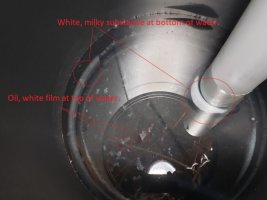WorldPeace
Member
My System Info
64k-56SXT-10
Brand AFWFilters
Capacity 64k
Resin 10% crosslink
Resin Tank Size 2.0 cubic ft
Brine Tank Size 18"x40" Round Brine Tank with Float and Air Check
Brine Fill Rate (BLFC) .5 GPM
DLFC 3.5 GPM
Injector #2
Service flow 10 GPM
Peak flow 15 GPM
Flow required for backwash 4 GPM
Water Hardness 27 GPG
4-Person Family
Municipal water
Diamond Crystal Pellets
Salt lb/cu ft 7.5
My brine tank recently got contaminated with some disgusting brown stuff in the brine tank similar to others have experienced. I don't know of sure but I'm guessing that I got a bad batch of salt (Diamond Crystal pellets). When I cleaned the controller, I noticed this white, milky substance coming out of the controller.
After cleaning the brine tank and then doing a manual regeneration after adding some bleach to the water, I noticed that the water after the brine draw wasn't clean. There was this white, milky substance that settled at the bottom of the brine tank. There was also this oily, white film on the top of the water. It was disgusting.
I did a 2nd regeneration after pouring Rheems water softener cleaner. The 2nd brine draw had less of this white substance. I am attaching a picture of this stage. (The brown stuff is actually the reflection of my basement beams so it has nothing to do with the water.)
I then performed a final 3rd manual regeration. The water was final clean.
However, this white milky, substance is disconcerting. It's apparently coming from the resin tank. I've scoured the internet and I noticed other experienced the same thing. But I found no answers to its resolution.
Does anyone know what it is?
Is this something I should be worried about?
(I feel disgusting because I cook with this water.)
64k-56SXT-10
Brand AFWFilters
Capacity 64k
Resin 10% crosslink
Resin Tank Size 2.0 cubic ft
Brine Tank Size 18"x40" Round Brine Tank with Float and Air Check
Brine Fill Rate (BLFC) .5 GPM
DLFC 3.5 GPM
Injector #2
Service flow 10 GPM
Peak flow 15 GPM
Flow required for backwash 4 GPM
Water Hardness 27 GPG
4-Person Family
Municipal water
Diamond Crystal Pellets
Salt lb/cu ft 7.5
My brine tank recently got contaminated with some disgusting brown stuff in the brine tank similar to others have experienced. I don't know of sure but I'm guessing that I got a bad batch of salt (Diamond Crystal pellets). When I cleaned the controller, I noticed this white, milky substance coming out of the controller.
After cleaning the brine tank and then doing a manual regeneration after adding some bleach to the water, I noticed that the water after the brine draw wasn't clean. There was this white, milky substance that settled at the bottom of the brine tank. There was also this oily, white film on the top of the water. It was disgusting.
I did a 2nd regeneration after pouring Rheems water softener cleaner. The 2nd brine draw had less of this white substance. I am attaching a picture of this stage. (The brown stuff is actually the reflection of my basement beams so it has nothing to do with the water.)
I then performed a final 3rd manual regeration. The water was final clean.
However, this white milky, substance is disconcerting. It's apparently coming from the resin tank. I've scoured the internet and I noticed other experienced the same thing. But I found no answers to its resolution.
Does anyone know what it is?
Is this something I should be worried about?
(I feel disgusting because I cook with this water.)

